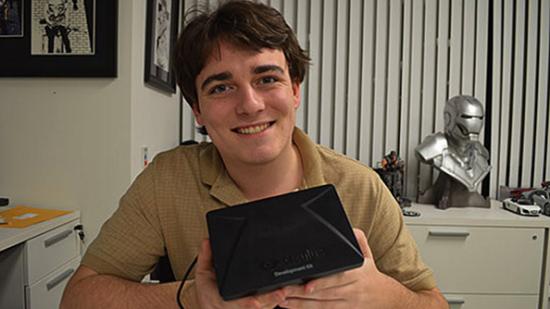In a passionate but nervous presentation at DICE, Oculus founder Palmer Luckey outlined the possible, ambitious future of virtual reality and the many hurdles ahead.
“It’s going to be driven by games,” Luckey said. But gaming isn’t the end of the road for VR. Luckey sees it spreading into entertainment more generally, as well as into hospitals and schools. But it’s the game developers at the front of the charge.
It will be a give and take relationship, though. While games will push VR forward and developers will find new ways to implement it, VR could also expand the number of people playing games, putting it further into the mainstream and making it more inclusive.
Luckey offered the stereotype of the “older” person struggling with technology, bringing up memories of me trying to teach my father to play ZombiU a year ago. The controls we take for granted, he explains, are complex; it’s obviously more intuitive to turn your head to look at something than it is to use a stick or some keys.
The game industry has been stagnating, according to Luckey. The games coming out this year are the same as the ones that came out last year, but VR is the “first technology in a long time that makes games feel different.” And VR itself is going to become very different over the next few years.
The Oculus Rift dev kit is primitive compared to what’s been developed over the last year, and “things are going to get much better very quickly,” Luckey said. Technology has already moved on quickly over a very short space of time, especially when compared to what Luckey sees as a lack of growth in the industry on the whole.
Ubiquitous VR where your headset can be used to play anything, haptic feedback and a real sense of presence where you subconsciously think you’re occupying the virtual reality – this is the future Luckey envisions.
But there will be hurdles.
Ports are problematic. There are so many concerns in virtual reality games that simply don’t exist in games designed for monitors or televisions. Light bulbs in games are the size of grapefruits, apparently. And while their gargantuan size isn’t obvious on a monitor, in virtual reality they look absurd. Doors, too, throw many spanners into the works. While the light bulbs are too big, doors are generally too small.
So games designed specifically for VR are obviously better, but even then there’s a long way to go.
Game audio is a bit guff when experienced in VR, according to Luckey. It hasn’t matched graphical fidelity, and when you move around, exploring your surroundings and interacting with objects, it becomes apparent that the audio is just not up to snuff.
Performance has to be top notch, too. A VR game has to run at 60FPS, be buffered, have v-sync enabled, and feature stereoscopic 3D or everything just feels a bit to off. If a game’s running at 30FPS, there will be a dissonance between what you’re seeing and what you expect to see, and that’s one of the causes of the headaches and nausea some people have been experiencing with the dev kit.
Despite all the things that still need to be done to provide a properly immersive VR experience, Luckey’s very optimistic about the future. He closes his presentation with, “I think virtual reality could be one of the most important technologies in the history of mankind.”
